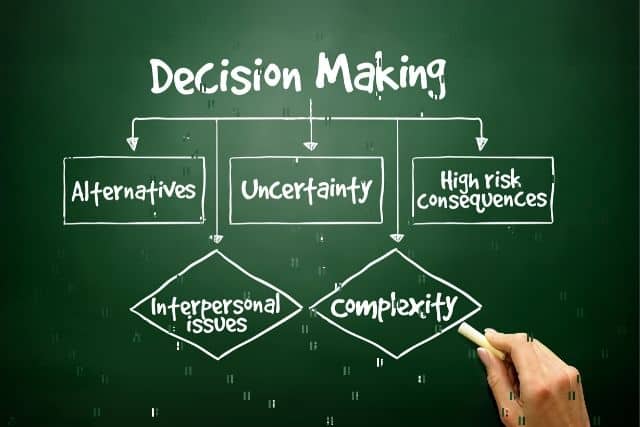Factors Affecting Decision Making Process of a Consumer
Various factors influence the decision-making process of a consumer. Some of these are internal factors or personal influences that are individualistic in nature. These factors are not visible, though they influence the consumer to a great extent. Learning, perception, motivation, attitude, self-concept, etc. are some such factors.
The processes by which these factors influence consumers have to be examined and understood by the marketer by conducting appropriate research.
The effect of these factors cannot be verbalized by the consumer, as he may not be able to realize their influence on him. For instance, motivation is one such factor about which traditional surveys reveal little, as the consumer is not able to tell the exact reasons for opting for a particular choice.
Qualitative, exploratory research using alternative methods such as projective techniques, word completion tests are used to ascertain consumer motivations.
Perception
Perception is the process by which a person selects, organizes, and interprets sensory stimulation to form a meaningful picture of the world. It is the process by which a consumer makes sense of the information that he receives.
Selective Attention
Exposure is the first step in the process of perception. The consumer has to first come across the stimulus or be exposed to it, to interpret it. Attention is the next step in this process.
Customers screen those stimuli that are not meaningful to them or they are not consistent with their experiences and beliefs. Consumers attend to only a small percentage of the communication to which they are exposed to.
Customers pay more attention to stimuli that contrast with their background than to stimuli that blend with it.
Size, color, position, and movement of the stimuli also affect attention.
Customers also notice those images that relate to their needs and those that provide surprises.
Selective Distortion
Consumers process the information they have paid attention to. Consumers assign meanings to these stimuli while interpreting them.
Consumers distort information, attitudes, and views. They may pretend that they misheard the message or they can discount the message source. Therefore, it is important to present the message clearly and use a highly credible source to minimize distortions.
Distortion can occur as people interpret the same information differently. For instance, a cheaper price may signify low quality to one consumer and value for money to another.
Framing is the way information is presented to people. The message should be positively reinforced.
Colors also influence interpretations. For instance, blue and green are considered to be cool colors and evoke feelings of security
Selective Retention
Only a selection of messages is retained in the customer’s memory. These messages are in line with the consumer’s existing beliefs and attitudes.
Selective retention reduces cognitive dissonance. For instance, when reading reviews of a recently purchased car, only positive messages are remembered.
The message about the product from word of mouth and advertising must be consistent to prompt retention.
Perception depends on the customer, the stimulus, and the situation.
Thus, the same message can be perceived differently by different individuals.
The quality of the stimulus can be enhanced to improve the probability of exposure, attention, and retention. Communication should be designed in a manner so as to enable distortion-free perception.
The same consumer can perceive some communication differently in varying circumstances. For instance, price off during festival con be interpreted as an event-related discount, whereas price offs at other times can be judged as poor brand performance.
Many phenomena related to consumers are driven by the process of perception – for instance, brand image, satisfaction, evaluation of brands, and marketing communication. Consumers form perceptions related to several marketing variables such as price, attributes, and their importance, country of origin of brands, corporate brands, salespeople, etc.
Learning
Learning is any challenge in the content or organization of long time memory and is a result of information processing. Perceptual processes lead to additions in memory if the interpreted information is retained. The customer’s memory acts as the internal information source in the decision-making process.
Classical Conditioning
When the relationship between a stimulus and response is used to cause learning of the different stimuli to the same response is known as classical conditioning. The repetitive appearance of the unconditioned and conditioned stimulus ensures that the removal of the unconditioned stimulus evokes the same response.
In advertising, humor which is known to elicit a pleasant response may be used in the belief that these favorable feelings will be associated with the product. The use of heavy metal music when advertising a soft drink imbues the brand with youthfulness and strength connotations.
The creation of brand personality involves using relationships that already generate a desired positive response from the intended target audience. Such images are combined with the brand to create the personality of the brand.
The use of colors, symbols, country of origin images, music in creating a brand image are associated with classical conditioning. The use of celebrity endorsements is also based on the belief that the positive image of the celebrity would rub off on the brand image.
Operant Conditioning
Learning also occurs through operant conditioning. Operant conditioning is positive or negative reinforcement upon the performance of some behavior. Sales promotions such as the use of free samples, coupons, price offs are instances of operant conditioning. If the consumer likes the product, he may purchase it the next time, which is positive reinforcement.
If he does not like it, he negatively reinforces this learning by not repeating the brand purchase or even spreading the negative word about it. A series of rewards may be used over time to encourage repeat buying of the product (coupons).
Repeat purchase behavior is shaped by the application of repeat reinforcers so that consumers will have learned that buying the product is associated with pleasurable experiences.
However, the product or brand offered by the marketer should be its own reward. Artificial rewards offered over a period of time may make the customer expect such rewards for buying the brand. He may also become conditioned to buy the product for the reward, and not for the intrinsic rewards offered by the product.
Repeat purchase behavior is shaped by the application of repeat reinforcers so that consumers will have learned that buying the product is associated with pleasurable experiences.
Cognitive Learning
Cognitive learning is the development of beliefs and attitudes without reinforcement. This type of learning primarily involves the communication of benefits offered by a product to the intended target audience.
The display of information and learning route is rational in nature. Rote learning is learning without conditioning in which companies repeat their messages that are primarily of a rational nature. Consumers are repeatedly exposed to such messages and thus learn about the company’s offerings.
Modeling/Vicarious learning
Vicarious learning involves learning from others without direct experience or reward. This type of learning involves copying others or modeling oneself on observed behavior in anticipation of certain rewards.
It is the promise of the reward which motivates in advertising. The ones who are copied may be product experts, admired for achievements, socially upmarket, or leaders with desirable values.
The ‘admiring glance’ can be used to signal approval of the type of clothing being worn. Consumers may imagine that the same may happen to them if they dress in a similar manner.
The desire to copy thus stems from the consumer’s need to belong or seek affiliation, make correct decisions, uphold similar values, or one’s aspirations in life that can be achieved by emulation.
Reasoning
Reasoning involves high involvement situations. Some advertising relies on the recipients to draw their own conclusions.
The result of learning is the creation of product positioning. The objective is to create a clear and favorable image or impression in the mind of the customer.
The company has to ensure that customers continue to learn about its products through advertising, publicity, sales promotion, salespersons‘ visits, and through their own experience with the products. It is only through learning that the customers form perceptions about the company and its products.
Motivation
The basic process of motivation involves needs that inspire actions to accomplish goals of fulfilling a need or reducing a drive.
Maslow ‘s theory of motivation
Abraham Maslow’s motivation theory gave one of the most popular theories of motivation.
The motives determine choice criteria. For instance, a customer who is driven by esteem and status motive may use self-image as a key choice criterion when buying a car.
Different consumers have varying motivations while buying the same product. Therefore, the choice criteria of various consumer segments differ, and marketers must choose the most relevant motivating factor while positioning their product.
For instance, some consumers may buy food for satisfying hunger, while some may frequent a fast food joint to hang out with friends or family, yet others may enjoy gourmet food service provided by a leading luxury hotel. Each segment considers different motives while buying the same product.
Therefore, while the segment that only wants to satisfy hunger may look for convenience or price, these factors may be inconsequential for the segment that wants gourmet food.
Belief and Attitude
Belief comprises thoughts about a product or a brand based on one or more choice criteria. A consumer believes that Swatch offers international quality watches, or a particular hotel has good room service.
A belief is not factual, is a perception that may or may not be factually correct. Misconceptions about products can be harmful to the sale of brands.
A consumer might think that a brand of durables is expensive because of the advertising imagery that it uses. He may not check the actual price of the brand at all. The company’s aim should be to ward off the misconceptions about their brand.
An attitude is an overall favorable or unfavorable evaluation of a product. The consequence of a set of beliefs may be positive or negative attitudes towards the product. They may be developed as a part of information search activities and/or results of product use.
Attitudes play an important role in product design through the designer’s efforts in matching product attributes to customer beliefs and attitudes.
They also play an important role in persuasive communications from the company which tries to reinforce positive beliefs and attitudes, correct misconceptions, and establish new beliefs. Customers’ attitudes and beliefs impact pricing in the way that the company tries to match the price with the customer’s beliefs about what a good product should cost.
Personality
Personality is the inner psychological characteristic of individuals that leads to consistent response to their environment. If marketers can identify the personality profile of the target market, advertising can show people of the same type using the product. Personality types could be extremes such as Introvert-Extrovert, Sociable-Loner, Competitive-Cooperative, etc.
Brand personality is the characterization of brands as perceived by customers. Brands may be characterized as ‘ for young’ like MTV or Levi’s. By creating a brand personality, a marketer may appeal to those people who value that characterization.
Customers prefer the brands that either match their own personality or portray personalities that they aspire for.
For instance, a laptop conveying efficiency and productivity could be identical to an executive’s personality. Apparel brands conveying success and material wealth could be aspirational for young executives.
Lifestyle
Lifestyle is the pattern of living as expressed in a person’s activities, interests, and opinions. Lifestyle analysis groups consumers according to their activities, values, and demographic characteristics such as education and income.
Lifestyles have been found to correlate with purchasing behavior. A company may choose to target a particular lifestyle group with a particular product offering and use advertising which is in line with the values and beliefs of this group.
Life Cycle
Disposable income, purchase, and purchase requirements may vary according to life cycle stages. Not all people follow the classic family life cycle stages. Consumer’s priorities regarding which products to buy undergo changes in different stages of the life cycle. His attitude towards life also changes.
A teenager is most bothered about his appearance, pleasing his peer group members, and having fun in life along with building a career. A middle-aged career person who is recently married is bothered about securing the family’s financial future, buying a house, etc.
Parents in a family with young children are most concerned about the future of the children and their comforts. In all these stages, a person’s spending pattern varies.
For teenagers, food, entertainment, and appearance would be the main areas where the money is spent. Among newly married couples, spending on house and furnishings, car, household essentials may be the areas where the money is spent, and for couples with children, their education, comforts are where the money goes.
Therefore, in various stages of the family life cycle, priorities about where to spend money, changes. The attitudes also undergo changes, with teenagers typically reflecting ego-centrism and carefree nature, and a full-nest family driven by responsibility and safety concerns.



